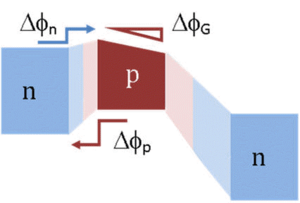Heterojunction bipolar transistor facts for kids
The heterojunction bipolar transistor (HBT) is a special type of bipolar junction transistor (BJT). It uses different semiconductor materials for its main parts: the emitter and the base. This creates something called a heterojunction.
HBTs can handle electric signals that move very, very fast. They can work with frequencies up to several hundred gigahertz (GHz). This is much faster than older types of transistors. HBTs are often found in modern super-fast electronic circuits. They are especially useful in radio-frequency (RF) systems. You can also find them in devices that need to use power very efficiently. A good example is the RF power amplifiers inside mobile phones. The idea of using different materials for a transistor, creating a heterojunction, has been around for a long time. It dates back to a patent from 1951.
How HBTs Work
The main difference between a regular BJT and an HBT is the use of different semiconductor materials. These materials are used for the emitter and base parts, creating a "heterojunction." This special design helps control how tiny particles, called "holes," move. It stops too many holes from going from the base into the emitter. This happens because the energy barrier for holes in the "valence band" is higher than for electrons in the "conduction band."
Unlike older BJT technology, HBTs allow a high amount of "doping" in the base. Doping means adding tiny amounts of other materials to change how the semiconductor works. This high doping makes the base have less resistance. Less resistance helps the transistor work better and maintain its "gain." Gain means how much the transistor can amplify a signal. Scientists use something called the Kroemer factor to measure how well a heterojunction works.
Uses of HBTs
HBTs are very important in today's fast-paced electronics. Their ability to handle high frequencies makes them perfect for many modern devices.
Mobile Phones
One common place you'll find HBTs is in mobile phones. They are used in the RF power amplifiers. These amplifiers boost the radio signals so your phone can send and receive calls and data clearly.
Other High-Speed Devices
Because they are so fast, HBTs are also used in other high-speed electronic circuits. This includes parts of radar systems and satellite communication. They help these systems process information very quickly and efficiently.
See also
- NCSR HBT at the Internet Archive
 In Spanish: Transistor bipolar de heterounión para niños
In Spanish: Transistor bipolar de heterounión para niños


